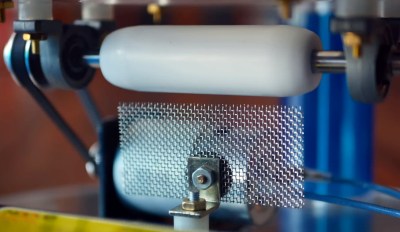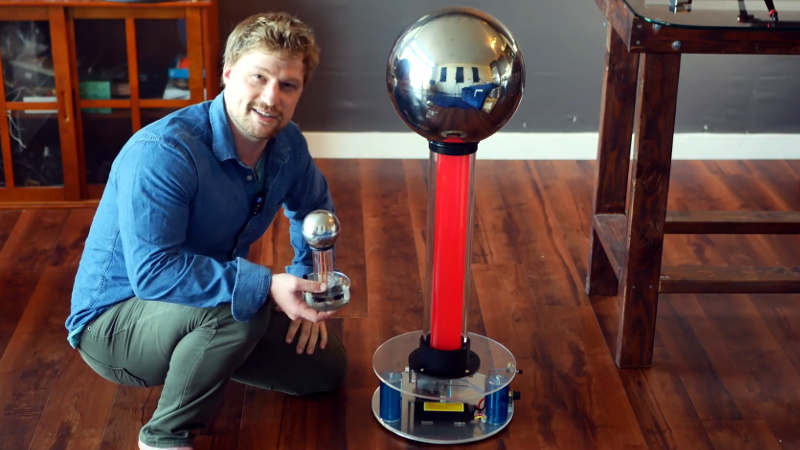The Van de Graaff generator is a staple of science museums, to the point that even if the average person might not know its name, there’s an excellent chance they’ll be familiar with the “metal ball that makes your hair stand up” description. That’s partly because they’re a fairly safe way to show off high voltages, but also because they’re surprisingly cheap and easy to build.
In his latest Plasma Channel video [Jay Bowles] builds a large Van de Graaff generator that wouldn’t look out of place in a museum or university, which he estimates is producing up to 500,000 volts. It can easily throw impressive looking (and sounding) sparks 10 inches or more, and as you can see in the video below, is more than capable of pulling off those classic science museum tricks.

It’s really quite amazing to see just how little it takes to generate these kinds of voltages with a Van de Graaff. In fact there’s nothing inside that you’d immediately equate with high voltage, the only electronic component in the generator’s base beyond the battery pack is a motor speed controller. While everything else might look suspiciously like magic, our own [Steven Dufresne] wrote up a properly scientific explanation of how it all works.
In this particular case, the motor spins a nylon pulley in the base of the generator, which is connected to a Teflon pulley in the top by way of a neoprene rubber belt. Combs made from fine metal mesh placed close to the belt at the top and bottom allow the Van de Graaff to build up a static charge in the sphere. Incidentally, it sounds like sourcing the large metal sphere was the most difficult part of this whole build, as it took [Jay] several hours to modify the garden gazing ball to fit atop the acrylic tube that serves as the machine’s core.
In the past we’ve seen Van de Graaff generators built out of literal trash, and back in 2018, [Jay] himself put together a much smaller and more simplistic take on the concept. But this beauty certainly raises the bar beyond anything we’ve seen previously.















A little bit disappointed by the video background music, I was expecting something more Hamill-ish…
This is quite a beautiful build from quality materials.
I wonder though how much experimentation was done with the electron combs. More and finer wires apparently work better. Ionized air generators use carbon fiber brushes with (many multiple?) thousands of hairs. Electrons are quite small you know.
The comb material doesn’t really matter as much as the clearance to the belt. I have used aluminum foil cut into a coarse comb with scissors and still managed 25cm sparks. In a dark room the comb actually glows as current jumps to the belt.
Excuse me. The shape of the charge collector at the top is quite simply *wrong*. Go look at the vastly better and bigger build that was published in the Amateur Scientist column of Scientific American. All of those are available on CD:
https://www.amazon.com/Scientific-Americans-Amateur-Scientist-Science/dp/0970347626
If you are even remotely interested in science hacking it’s a must. There is a high school science fair build of a supersonic wind tunnel. And a 250 kV linear particle accelerator among many other *very* sophisticated projects.
How is the charge collector wrong? I can understand not wanting sharp points, to spread the charge around the collector, but beyond that, something spherical-ish is a common shape.
But Van de Graaff’s generator that’s on display at the Boston Museum of Science has two conjoined spheres. Is that what you were expecting? https://en.wikipedia.org/wiki/Van_de_Graaff_generator
Also, the Boston Museum of Science generator is 22 feet tall, so I was hoping for something supersized from that. 3 feet is cute, though.
The best I can offer verbally is a “mushroom shape”. The issue is the radius of curvature where the column and belt attach to the collector.
From the “Scientific American Book of Projects for The Amateur Scientist” edited by C.L.
Stong. “The maximum potential developed by the machine will be 70,000 times the smallest radius of the collector in inches.”
“The most effective compromise with the ideal shape for a practical collector is a spheroid slightly flattened at the bottom, with minimum radius of curvature located at a reasonable distance from the insulator to discourage sparking along the insulator surface.”
However, looking at other examples in the book I see shapes that suggest that the figure I remembered is not especially accurate. My recollection was it was an optimal shape.
After review of my sources, I’d have to say it’s ambiguous. Multiple figures show very different profiles for the collector.
I printed a 12″ sphere using conductive PLA, the top half is spherical, the bottom is a toroid folding into the top end of the tube. The Faraday pail effect suggests that as the outside becomes the inside (rounding that bottom radius) the charge should diminish. It does. In reality? I don’t know how much it actually matters, I’m getting equivalent arc length as the unit shown here. My original thinking came from a top collector on a 1 million volt Cockcroft multiplier I saw as a kid. Rock on!
Literally every van de graff I’ve ever seen has looked like this. It’s the quintessential design.
I’ve built several VDG’s over the last 5 decades and for a reasonably sized desktop unit (under 3ft. tall) I’ve discovered I get best results with a collector having a spherical top and half of a torus as the bottom. Looks like a sphere that someone sat on viewed from the side, the height is about 2/3 the diameter to have as large a radius as possible on the toroidal X-section. Shame I can’t attach a pic. from CAD here. Also I print collectors now from conductive PLA and sand them smooth, only limited by imagination now…Awesome Fun!
Metals and PTFE are at opposite ends of the triboelectric series, so a metal roller on the bottom and a PTFE roller on the top result in maximum charging current (shorter spark to spark time). The bottom roller can be a plastic roller covered with aluminum or copper tape, and the top roller covered with PTFE tape like the type used in vacuum food sealers.
The upper terminal can be made from a pair of Ikea Blanda serving bowls. You can go up to 14″ diameter with them and draw 600 mm sparks under dry conditions (winter in Wisconsin).
I 3D printed the rollers and some of the other parts, and used bearings scavenged from HDDs for the rollers.
Cheap drain pipe can be used for the tube, and almost any DC motor. I used exercise bands for the belt in my VDG.
https://drmrehorst.blogspot.com/2018/10/van-de-graaff-generator-redux.html
https://drmrehorst.blogspot.com/2019/02/van-de-graaff-generator-update.html
Hi, i’m the creator of the video in this thread. 600mm sparks is insane. That is impressive. After shooting this video, I added a corona ring to the base of my sphere, and am able to draw 11-12″ sparks consistently, but 600mm is really impressive.
Nylon works great for the bottom as well, in fact there’s an even greater spread between Nylon and Teflon on the Triboelectric chart if I remember correctly. Maybe your concern is that Nylon’s hygroscopic? Oddly enough it doesn’t seem to matter, being retired and having plenty of time I’ve tried literally dozens of combinations of roller materials and about 6 or 7 belt materials. I currently purchase a belt online from a supply house that works well, I don’t have to join and glue the ends which I tend to make a mess of.
so my pajama in a van de graaff generator, its very funny when i taking off tha shirt of the pajama and its rubbing in my hair and i feel the sparks, with the light turned off you can even see the sparks
That sounds like you wear a pajama made from synthetic fiber like polyester. I prefer cotton, although (or because :-) ) it does not charge up.
Years back, I built a similarly-sized VDG from two 12″ steel IKEA mixing bowls that easily threw off 10-12″ sparks on a dry day. Also threw off a lot of EMF radiation which, during one late-night test session, remotely triggered the siren on my daughter’s toy fire engine two floors above and “woke up the baby.” One good test for whether you’re a Mom or a Dad is how you react to this story. Dads uniformly say “oh, cool.” Moms — my wife included — are a lot less amused.
Can this Generator be set to produce a positive. or negative output voltage?
I really wish he would make a parts list for his builds. I have NO idea where to even get rollers like the ones he used, especially the Teflon one. Google keeps showing me paint rollers and exercise rollers. 🤦
Teflon tape with an adhesive backing ( brown colored weave with a Teflon coat) works great and is cheap. I print my rollers, both Nylon, but Somebody else had a great idea: Bedframe rollers. Some have the right shape with that slight bulge in the middle and are often Nylon for durability. I put the tape on the top roller.
Has anyone recorded off You Tube people building and showing their van de gaff generators in front of their garages ? some of these were huge and put on a great show this was early you tube videos.